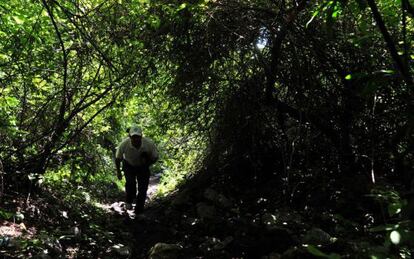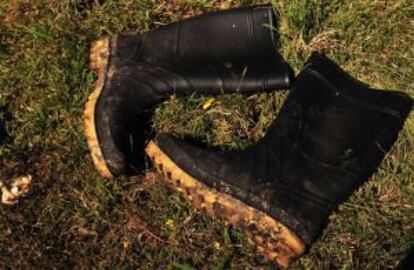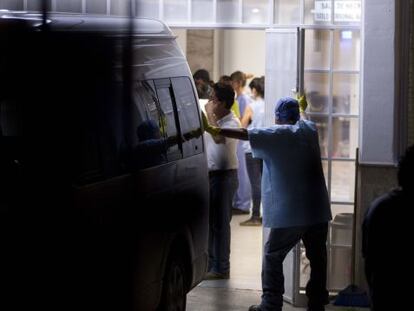In the footsteps of the massacred Mexican students
Bodies of youths allegedly killed by Guerrero police lie in mass grave at end of isolated path


Camino Real de Iguala, a tract of land and stones lined by small homes on both sides, eventually tapers to a point at which it becomes impossible for cars to pass. From there on, travelers have to clear the path with a machete. Locals say even dogs carry machetes around here. After an hour, the uphill road leads to a hill in Pueblo Viejo where Mexican authorities say they discovered 28 burned corpses. All that is left of the massacre that has kept the country on tenterhooks are a belt, a straw hat hanging from a tree branch, a pair of women’s trousers and a few bones that the forensic team seems to have left behind. This isolated, almost inaccessible, verdant corner – it is not quite a jungle – is drug cartel territory.
The reconstruction of events made by investigators indicate that the student teachers were killed here a week ago. According to the version offered by the hitmen and the arrested police officers, municipal police stopped the students after they crashed an event held by the mayor’s wife in Iguala. They allegedly seized some buses, which they intended to use to get out of town.
We saw the police take them away. Now they want to wash their hands of the issue by saying it was organized crime”
A student spokesman
Two students died in the first shooting in the streets. The rest were taken to the police station where they were allegedly turned over to some hitmen from the Guerrero Unido cartel. Drug dealers were annoyed by the students’ interfering in their territory and considered them troublemakers.
“The murderers had to come to this fork in the road by truck and they then had to transfer the victims on foot. There is no other way,” a guide says on the side of the hill. This craggy road is about two meters wide and surrounded by thick vegetation and vines that have to be sidestepped. The path begins to narrow after about 20 minutes and the track becomes single file. “We can already smell the rotting,” says one member of the National Human Rights Commission, which began taking trips up here on Monday. Rescue services have left face masks and boots on the ground. The last stretch of the road that leads to the clearing where the bodies were found is especially steep and from here we can already see the police tape marked “caution.”
The unmarked graves are in the middle of the hill, in a hollow hidden behind trees. The undergrowth, slope and wild animals make the site inaccessible to the authorities and for many years it has served as a hiding place for drug cartels – hiding out in the mountains is a practice with deep roots in the region’s guerrilla history. Here, investigators say, the assassins executed the victims and threw them in the holes they had dug that same night. They threw bodies against tree trunks and then added more bodies to build a pyre using gasoline. The leftovers from the bonfire – clothes, bottles, cigarette butts – are still on the ground. It took at least four members of the medical forensic team, secured with a rope, to take the bodies down the hill. DNA testing to confirm the identities of the victims could take weeks.

The students’ relatives have not visited the graves because they do not believe the remains there belong to their loved ones and question the authorities’ account, which points to collusion between drug cartels and police. Iguala is covered with posters showing the faces of the students and offering a $77,000 reward to anyone providing a clue that helps find them. “We saw the police take them,” says one student spokesman from the neighboring municipality of Ayotzinapa. “It couldn’t have been organized crime. We have done nothing to them. They want to wash their hands of the issue by saying it was organized crime.” President Enrique Peña Nieto has gotten involved in the case and the situation has raised doubts about the government’s ability to control Guerrero. A year ago, federal reports revealed that Iguala’s mayor and his chief of police were working with drug cartels. They are currently fugitives at large.
A taxi driver lives on the side of the path the killers and the victims took. He christened his youngest daughter on Sunday in a tent that a brother-in-law helped him put up. The guests drank tequila and ate barbecued pork while the medical forensic team carried the corpses down the hill. Members of the police and military who had been working non-stop for hours recovering the bodies joined in the banquet. The taxi driver did not put the music too loud out of respect for the dead, but he did go to the store to buy more alcohol to console the living.
Translation: Dyane Jean François
Tu suscripción se está usando en otro dispositivo
¿Quieres añadir otro usuario a tu suscripción?
Si continúas leyendo en este dispositivo, no se podrá leer en el otro.
FlechaTu suscripción se está usando en otro dispositivo y solo puedes acceder a EL PAÍS desde un dispositivo a la vez.
Si quieres compartir tu cuenta, cambia tu suscripción a la modalidad Premium, así podrás añadir otro usuario. Cada uno accederá con su propia cuenta de email, lo que os permitirá personalizar vuestra experiencia en EL PAÍS.
En el caso de no saber quién está usando tu cuenta, te recomendamos cambiar tu contraseña aquí.
Si decides continuar compartiendo tu cuenta, este mensaje se mostrará en tu dispositivo y en el de la otra persona que está usando tu cuenta de forma indefinida, afectando a tu experiencia de lectura. Puedes consultar aquí los términos y condiciones de la suscripción digital.









































